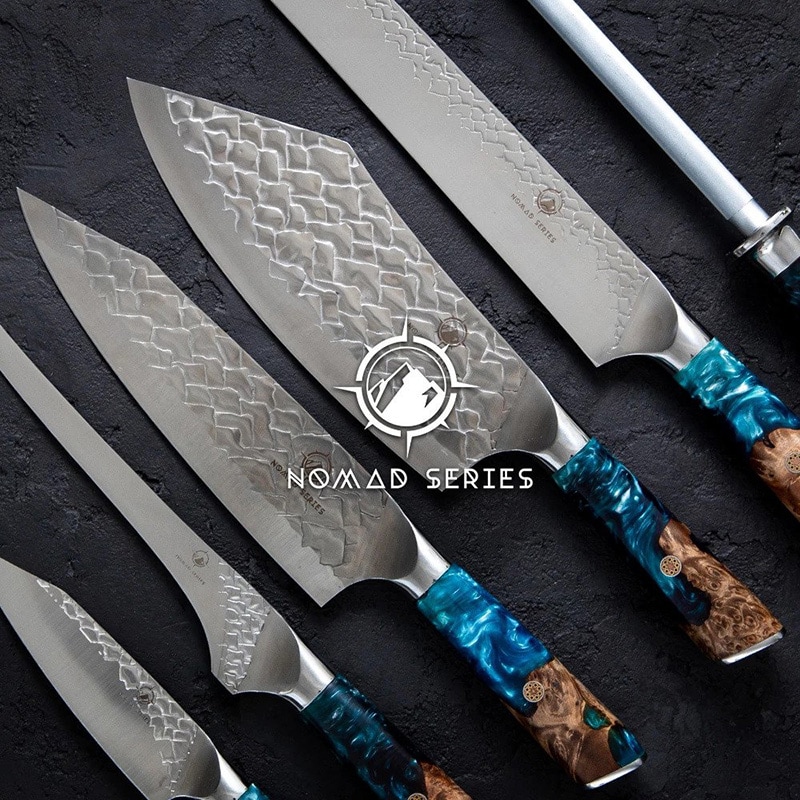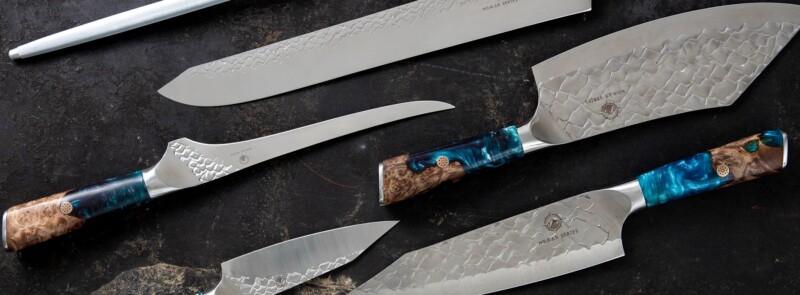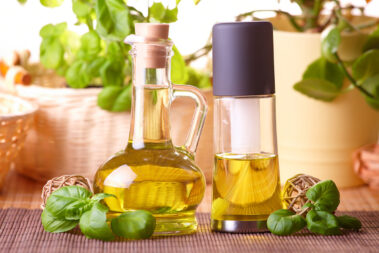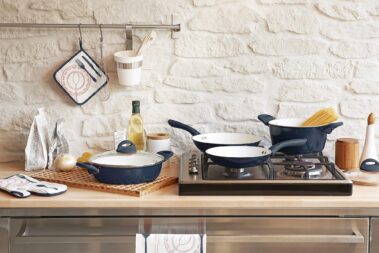Adding a quality knife set to your kitchen arsenal is the easiest way to make meal prep more enjoyable. Knife sets also make awesome gifts for any passionate home chef you know.
In this article, we’ll tell you how to choose the best knife set for you and your budget. We’ll also share with you a beautiful knife set, The Nomad Series by The Cooking Guild. These gorgeous knives are perfect for gifting but so effortless to use, you’ll want to keep them all to yourself.
Table of Contents
What to Look for in a Knife Set
Knife sets range in price from as low as $20 to higher than $2,000. As you can imagine, there’s quite a bit of difference between sets on each end of this spectrum. But somewhere between these extremes tends to be the sweet spot for finding quality, long-lasting, well-performing knives at a reasonable price.
But figuring out which sets are worth it and which are overhyped takes careful investigation. To know what you’re getting, you’ll want to consider the material used, how the knives were made, and a few other key factors that will help you determine if a knife set is worth the cost.
Material
Kitchen knives are typically made with one of four common material types. Each has its own pros and cons worth considering before you buy.
Stainless Steel
Stainless steel knives are the most common. They come in various gauges that have different price points and different levels of durability.
Stainless steel blades are resistant to rusting and damage, they are highly versatile in the kitchen, and come in a variety of shapes and sizes. Most are easy to maintain and can be put in the dishwasher, though hand washing will help extend their lifespan. These kinds of knives are widely available and are made to fit any budget.
But there are also some drawbacks to standard stainless steel knives. Compared to some other materials, stainless steel blades aren’t often as sharp, especially cheaper sets. They are also more likely to dull quickly, can be on the heavier side, and can get stained when exposed to acidic foods.
Carbon Steel
Carbon steel is one step up from stainless steel. These quality knives can be sharpened to a finer edge than most stainless steel options and retain their edge far longer. They are also very easy to sharpen at home and highly responsive to honing, allowing for better control over the edge shape and sharpness.
But, on the downside, carbon steel gets stained easily and is more prone to corrosion. They are more reactive with foods than stainless steel and will develop a patina over time. Carbon steel requires careful maintenance, including hand washing and thorough drying, to ensure they last.
Damascus Steel
Damascus steel knives combine many advantages of stainless steel and carbon steel. These blades are forged with multiple layers of steel to create a stronger, more durable blade that holds an incredibly sharp edge for longer. These knives also typically feature distinctive patterns in the steel that makes them aesthetically pleasing while retaining the stain and corrosion resistance of standard stainless steel.
Unfortunately, true Damascus steel knives can be hard to find and are rather expensive. They can also be tricky to sharpen at home and lower-quality options are prone to chipping due to the multiple layers.
Ceramic
Ceramic knives are less common but have many advantages that make them worth considering. Quality ceramic knives are exceptionally sharp and lightweight, which makes them easier to use. They’re also non-reactive with foods and moisture, easy to maintain, and won’t rust or tarnish.
On the downside, ceramic blades can be brittle and fragile. They are not meant to cut hard objects like frozen food and can chip or snap if twisted. They’re less versatile than metal knives, require special sharpening, and often carry a high price tag.
Blade Construction
Once you know what kind of blade material will work best for your needs and budget, the next thing to consider is how that blade is constructed.
Most budget knife blades consist of stamped metal, which is cut out of a flat piece of steel and then sharpened to an edge on one side. These are more likely to bend and are not as durable as forged blades.
Forged blades are made by heating and molding steel. These tend to be more durable, retain a sharper edge for longer, and offer better balance and performance.
Handle Type
For a knife to be enjoyable to use, the handle has to be comfortable to grip and work with. What the handle is made of plays into its comfort and also contributes a lot to the product’s durability and lifespan.
Plastic
Plastic knife handles are made with various types of polymers. These handles are fairly durable and resistant to impact and moisture but are prone to scratching and breaking down over time. Plastic handles can be made to have a variety of finishes and can feature textured grips that make the knife easier to manipulate.
Resin
Resin handles are made using epoxy, acrylic, and phenolic resin. They are very durable, resistant to heat, chemicals, and moisture. And they are less likely to chip or break compared to plastic. They also come in a variety of colors, textures, and patterns.
Wood
Wood handles offer a unique aesthetic that many find more pleasing. They also tend to be more comfortable to grip and come in a variety of finishes and shapes. But they are far more sensitive to the elements than other types and require careful handling, especially if the wood is raw or only lightly finished.
Tang Style
The tang is the extension of the blade that attaches to the handle. The shape and length of the tang play a large role in how durable the knife is.
Full Tang
A full tang extends the entire length and width of the handle, with the handle scales attached on either side. This kind of tang provides excellent strength, balance, and durability. But these knives tend to be heavier and more expensive compared to other tang styles.
Partial Tang
A partial tang, also known as rat-tail tang, is a narrower extension of the blade that tapers into the handle. Partial tang knives are lighter and more affordable, but they are less durable and more prone to breakage. They lack the same level of balance and stability as full tang knives.
Half Tang
Half-tang knives are narrower than full tang and only extend to the midpoint of the handle. These knives are more affordable, lighter weight, and allow for greater flexibility in cutting since the blade is more likely to bend with pressure. But these knives are also much less durable and more likely to experience handle breakage and blade instability.
Maintenance
The maintenance requirements for a knife set, including sharpening and washing needs, are important to consider before you buy.
Sharpening
Many cheaper sets of stainless steel knives can be sharpened at home with ease, but these tend to need sharpening far more often. Carbon steel knives can be sharpened easily and require less frequent sharpening. More expensive blades, including Damascus steel and ceramic, only need to be sharpened on occasion but usually have to be taken to a professional to get it done.
Wash Requirements
Many knife sets, including some stainless steel and all ceramic sets, are resistant to moisture and can be washed easily in the dishwasher. But other materials require more careful handling, including hand washing and thorough drying. We recommend hand washing for all quality knives to help extend their lifespans.
Warranty
Another thing to consider when looking at any knife set is the warranty that comes with it.
Knives include warranties that reflect the manufacturer’s confidence in their durability. Most inexpensive sets will not include a warranty or only have a short warranty period. We expect to see at least a two-year warranty on more expensive sets, though a lifetime warranty is what we prefer to see.
What Knives Should be Included
Knife sets come in various sizes. Small sets may only include a few commonly used blades while large sets will include these and other useful and unique options. Before you purchase a new set, consider what jobs you will use your knives for the most.
Most Popular Knives
These are the most commonly used knives by home chefs and the ones that will likely be featured in any quality starter set.
- Chef’s Knife – This versatile, all-purpose knife typically has a broad, tapered blade ranging from 6 to 12 inches. It’s ideal for chopping, slicing, dicing, and mincing a variety of ingredients.
- Petty Knife – Similar in shape to a chef’s knife, a petty knife or utility knife is smaller, between 4 and 7 inches. It has a narrower blade with a slight curve and a pointed tip. It’s a versatile knife used for precision jobs similar to a paring knife but features a longer blade.
- Paring Knife – This is a small knife with a plain edge blade usually around 3 to 4 inches long. Paring knives are great for intricate tasks like peeling, trimming, and precise cutting. If the set doesn’t have a petty knife, a paring knife is a good second option.
- Slicer Knife – Also known as a carving knife, a slicer knife is a long, narrow knife specifically designed for slicing large cuts of meat. It’s characterized by its long, thin blade, sharp edge, and pointed tip. In the vegan kitchen, slicers are useful for cutting cakes, bread, and other soft foods.
Other Knives Worth Considering
In addition to the popular knives above, you may find some of these less common knives helpful to have in the kitchen.
- Carving Knife – With a long, narrow blade and a pointed tip, carving knives are ideal for slicing cooked meats into thin, even slices. For vegans, carving knives are helpful for slicing through whole roasted squash, cauliflower, and other thick vegetables.
- Cleaver – A cleaver is a heavy, rectangular knife with a thick blade, typically used for chopping through bones and dense cuts of meat. It’s also handy for smashing garlic or ginger or slicing through hard veggies like pumpkin and parsnip.
- Filet Knife – This is a flexible knife with a narrow blade, ideal for fileting fish and removing the skin. The flexibility allows for precise maneuvering around bones, vegetable rinds, and veggie skins.
- Tomato Knife – This knife has a serrated or scalloped blade and a forked tip, perfect for slicing through delicate fruits and vegetables with tough skins, like tomatoes.
- Bread Knife – This knife has a long, serrated blade designed to slice through crusty bread without crushing it. The serrations allow for a sawing motion.
- Santoku Knife – Originating from Japan, the Santoku knife features a shorter, wider blade than a chef’s knife with a flat edge and a rounded tip. It’s excellent for slicing, dicing, and mincing vegetables, fish, and boneless meats.
- Boning Knife – This knife has a thin, flexible blade specifically designed for separating meat from bones. It’s commonly used for deboning poultry and fish or trimming fat. These knives are equally capable of removing fruit and vegetable cores, seeds, and rinds.
Our Favorite Knife Set: The Cooking Guild’s Nomad Series

Now that you know what defines a quality knife set, let us save you some time shopping by sharing our favorite knife set.
The Cooking Guild, which produces a number of beautiful, functional knives, has recently released a new knife series that we absolutely love. The Nomad Series features gorgeous patterned knife blades made of German 1.4116 stainless steel.
These foraged blades are handcrafted for strength and durability. The patterning, which mirrors mountain peaks to represent the nomad spirit, is similar to what you see on true Damascus blades. While these high-quality knives are made with the same focus on quality and using similar techniques, these knives are far more affordable.
The blades aren’t the only thing worth gawking at on this set. The handles are pretty eye-catching, too.
They’re made of finished burl wood and deep sea blue epoxy to represent where land and sea meet. Each handle has a unique design and a grip that is so comfortable it’s hard to put these knives down.
The full tang is hidden within the gorgeous handle with a stamped steel disc on the end.
These ultra-sharp knives make any chopping or slicing task as easy as cutting through butter. And, while they come with a lifetime warranty and the durability we’d expect from premiere knives, the price point on these is remarkably affordable considering what you get.
If you’re looking for a gift that is certain to impress any loved one, this knife set could be the way to go. Or, if you just want to treat yourself to knives that are as pleasing to use as they are to look at, these are absolutely worth the indulgence.
The Nomad Series is available in three different-sized sets or by the individual knife. Click here to see which set will work best for you or to learn more about these amazing knives.
- How to Pick the Perfect Watermelon For a Sweet Summer Treat - April 10, 2024
- Future Kind’s Foundations: A Multivitamin Made for Vegans - December 5, 2023
- Does Nutritional Yeast Go Bad? - November 28, 2023







